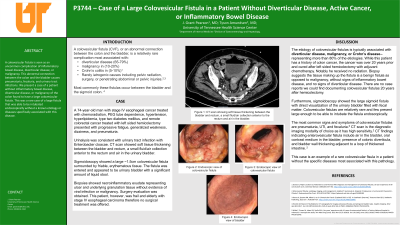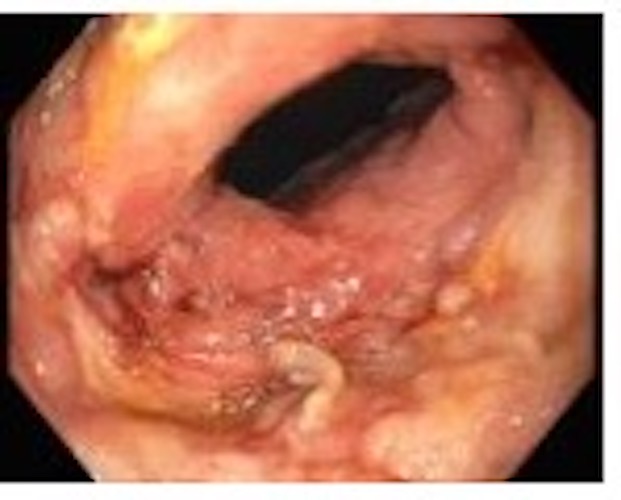Tuesday Poster Session
Category: Colon
P3744 - Case of a Large Colovesicular Fistula in a Patient Without Diverticular Disease, Active Cancer, or Inflammatory Bowel Disease
Tuesday, October 29, 2024
10:30 AM - 4:00 PM ET
Location: Exhibit Hall E

Has Audio

James G. Pearson, MD
University of Tennessee Health Science Center
Memphis, TN
Presenting Author(s)
James G. Pearson, MD, Tyson Amundsen, MD
University of Tennessee Health Science Center, Memphis, TN
Introduction: A colovesicular fistula, or an abnormal connection between the colon and the bladder, is a relatively rare condition most associated with diverticular disease in 65-79% of cases, active malignancy in 10-20% of cases, and Crohn’s colitis in 5-10% of cases. We present a case of a man with a remote history of colon cancer treated with left sided hemicolectomy with a large colovesicular fistula presenting decades after hemicolectomy without recurrence of his cancer, history of radiation, diverticular disease, or development of inflammatory bowel disease.
Case Description/Methods: A 74-year-old man with a past medical history of hypertension, hyperlipidemia, type two diabetes mellitus, and remote colorectal cancer treated twenty five year prior with a left sided hemicolectomy admitted to the hospital with pneumaturia and a urinary tract infection. CT scan of the abdomen revealed soft tissue thickening between the bladder and rectum, a small fluid/air collection anterior to the rectum and air in the urinary bladder. Sigmoidoscopy discovered a large, ~1.5cm colovesicular fistula. The fistula was intubated endoscopically revealing urinary bladder. Biopsy of the tissue surrounding the fistula showed necroinflammatory exudate and granulation tissue. There was no malignancy, viral infection, or inflammatory bowel disease present. He was not a candidate for surgical intervention due to frailty and was discharged home with hospice care.
Discussion: The etiology of colovesicular fistulas is typically associated with diverticular disease, colon malignancy, or Crohn’s disease, representing more than 80% of the etiologies. While iatrogenic and radiation induced etiology can occur more rarely, our patients previous malignancy and surgery occurred over 20 years prior to developing this fistula. He never received pelvic or abdominal radiation therapy. This case is unique as it represents development of a fistula 20 years after a hemicolectomy with a negative biopsy for recurrent malignancy, diverticular disease, or development of inflammatory bowel disease. No case reports were found documenting a colovesicular fistula occurring this long after a hemicolectomy. Furthermore, this case shows diagnosis of a colovesicular fistula by CT scan and further visualization with endoscopic view of the urinary bladder from the colon. This could suggest a need for further surveillance and study of hemicolectomy patients far removed from surgery for late fistula development.

Disclosures:
James G. Pearson, MD, Tyson Amundsen, MD. P3744 - Case of a Large Colovesicular Fistula in a Patient Without Diverticular Disease, Active Cancer, or Inflammatory Bowel Disease, ACG 2024 Annual Scientific Meeting Abstracts. Philadelphia, PA: American College of Gastroenterology.
University of Tennessee Health Science Center, Memphis, TN
Introduction: A colovesicular fistula, or an abnormal connection between the colon and the bladder, is a relatively rare condition most associated with diverticular disease in 65-79% of cases, active malignancy in 10-20% of cases, and Crohn’s colitis in 5-10% of cases. We present a case of a man with a remote history of colon cancer treated with left sided hemicolectomy with a large colovesicular fistula presenting decades after hemicolectomy without recurrence of his cancer, history of radiation, diverticular disease, or development of inflammatory bowel disease.
Case Description/Methods: A 74-year-old man with a past medical history of hypertension, hyperlipidemia, type two diabetes mellitus, and remote colorectal cancer treated twenty five year prior with a left sided hemicolectomy admitted to the hospital with pneumaturia and a urinary tract infection. CT scan of the abdomen revealed soft tissue thickening between the bladder and rectum, a small fluid/air collection anterior to the rectum and air in the urinary bladder. Sigmoidoscopy discovered a large, ~1.5cm colovesicular fistula. The fistula was intubated endoscopically revealing urinary bladder. Biopsy of the tissue surrounding the fistula showed necroinflammatory exudate and granulation tissue. There was no malignancy, viral infection, or inflammatory bowel disease present. He was not a candidate for surgical intervention due to frailty and was discharged home with hospice care.
Discussion: The etiology of colovesicular fistulas is typically associated with diverticular disease, colon malignancy, or Crohn’s disease, representing more than 80% of the etiologies. While iatrogenic and radiation induced etiology can occur more rarely, our patients previous malignancy and surgery occurred over 20 years prior to developing this fistula. He never received pelvic or abdominal radiation therapy. This case is unique as it represents development of a fistula 20 years after a hemicolectomy with a negative biopsy for recurrent malignancy, diverticular disease, or development of inflammatory bowel disease. No case reports were found documenting a colovesicular fistula occurring this long after a hemicolectomy. Furthermore, this case shows diagnosis of a colovesicular fistula by CT scan and further visualization with endoscopic view of the urinary bladder from the colon. This could suggest a need for further surveillance and study of hemicolectomy patients far removed from surgery for late fistula development.

Figure: Endoscopic image of opening of colovesicular fistula
Disclosures:
James Pearson indicated no relevant financial relationships.
Tyson Amundsen indicated no relevant financial relationships.
James G. Pearson, MD, Tyson Amundsen, MD. P3744 - Case of a Large Colovesicular Fistula in a Patient Without Diverticular Disease, Active Cancer, or Inflammatory Bowel Disease, ACG 2024 Annual Scientific Meeting Abstracts. Philadelphia, PA: American College of Gastroenterology.
